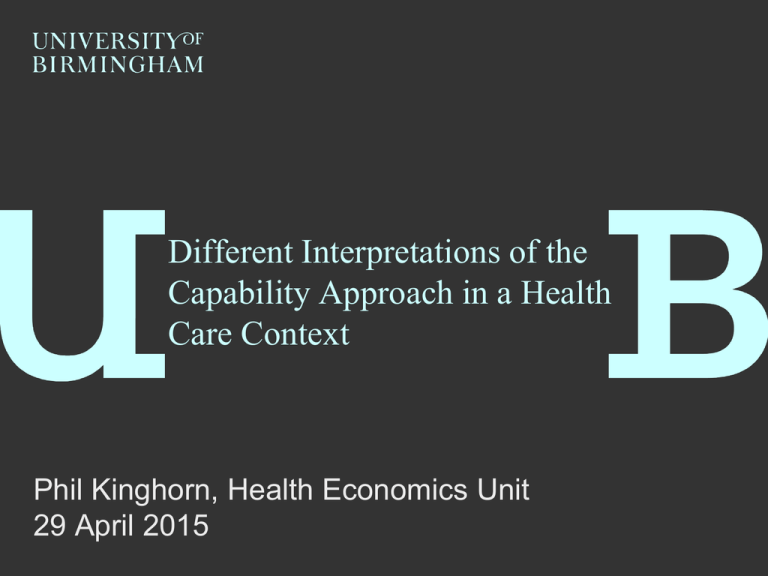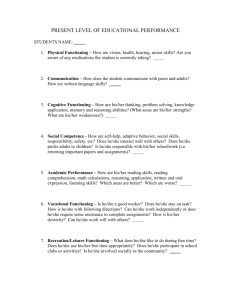here
advertisement

Different Interpretations of the Capability Approach in a Health Care Context Phil Kinghorn, Health Economics Unit 29 April 2015 Aim To explore different interpretations of the capability approach and understand: – The key ways in which they differ – Reasons why they differ – Strengths and weaknesses – Areas for future research Structure The capability approach: Identifying broad guiding principles Health and social care as a means of expanding a broad capability set: ‘expansion’ The capability to experience a sufficient quality of health: ‘policy focus’ The future GUIDING PRINCIPLES of an incomplete conceptual theory Informational Space Happiness/ pleasure not of exclusive relevance Income/ resources inadequate indicators of wellbeing Functionings and capabilities are of importance Valuation Valuing not the same as desiring or experiencing happiness Capabilities will have different weights in different contexts Decision-Making No requirement to entirely equate people’s capabilities EXPANSION Context Publicly funded health care services for all those in need Allocation of resources informed by cost-utility analysis Quality-Adjusted Life Years Q = Health-related quality of life – Commonly assessed using EQ-5D L = survival duration QALY = Q x L Limitations of QALYs Narrow interpretation of health – Health interventions often have a broader impact (not assessed) – Does not capture our experience of receiving healthcare – We cannot always cure a condition, so focus may shift to helping the patient live with it as best as possible. Not appropriate for evaluating public health & social care – Again, because too narrow Health Health is a state of complete physical, mental and social well-being and not merely the absence of disease or infirmity Three approaches: OCAP/OxCAP/OxCAP-MH – Public health, including mental health ICECAP-A, ICECAP-O, ICECAP-SCM – Health and social care in adults, older people and at the end of life Assessing capability in patients with chronic pain Expansionist interpretations Expert-led versus participatory – Based upon Nussbaum’s 10 central capabilities – Developed through in-depth qualitative work Combinations of attribute phrasing (functioning versus capability) Participatory approaches Chronic Pain Love & social inclusion Enjoyment Respect & identity Remaining physically & mentally active Societal & family roles Independence & autonomy Physical & mental wellbeing Feeling secure about the future ICECAP-O Attachment (love & friendship) Security (thinking about the future without concern) Role (doing things which make you feel valued) Enjoyment (enjoyment & pleasure) Control (being independent) Expert led approach Love & social support Social networks Enjoy recreation Appreciate nature Respect & appreciation Discrimination Freedom of expression Employment Discrimination Imagination & creativity Daily activities Influence local decisions Planning one’s life Suitable accommodation Life expectancy Losing sleep Property Ownership Neighbourhood safety Potential for assault Expansionist interpretations Valuation versus equal weights – Multi-attribute Valuation (Swing-Weighting) exploratory – Best-worst scaling – Equal weights Loosely assumes a cost-consequence type framework (costs and outcomes disaggregated) QALYs versus UK (expansionist) approaches Budget Budget Health system Any sector Impact Health functioning Impact Broad capability set (incl. Health?) Compensation No scope for wellbeing to be increased in other ways Compensation Health one contributor to wellbeing Observation/Critique OxCAP instruments likely to be used alongside EQ5D Capture additional evidence for decisionmakers to consider ICECAP instruments typically used alongside EQ-5D in practice Evidence that the two instruments capture different things What about health in a more immediate clinical sense? Observation/Critique Does inclusion alongside EQ-5D in a costconsequence type analysis represent the ‘easy option’ or perhaps a lack of consideration of how capability theory can appropriately shape the decision-making framework? What about a decision-rule?? Decision-Making - Mitchell (2013) Adoption of an approach based on AF multidimensional poverty measures Sufficient capability HEALTH CAPABILITY Focus on health: Ruger’s Health Capability Paradigm “a lack of consensus on moral norms relating to distributive justice” (Ruger, 2010, p14) Health Capability Paradigm Health Capability Health Agency Avoidable mortality Avoidable morbidity – Health functioning – Assessed using (mostly) existing measures – such as SF-36 Health knowledge – Extent to which individuals are able to make informed decisions No place for preferences as preferences may not align with health need Observation/Critique Extends what is incorporated into QALYs by considering health agency in addition to health capability (or health functioning). By incorporating information about preventative interventions, health guidance/advice and access to services it encompasses many public health type objectives But how to assess health knowledge/health agency is not clearly specified. QALYs versus Health Capability Budget Budget Health system Any sector Impact Health functioning Impact Health functioning & Health agency Compensation No scope for wellbeing to be increased in other ways Compensation No scope for wellbeing to be increased in other ways Short-fall sufficiency Used to determine need/priority “…priority goes to individuals who exhibit a gap between their health status and the status they could achieve, and those with the greatest deficit in health status should receive the highest priority. Priority is placed on all deprivations below the shortfall equity norm” » Ruger (2009, p269) Allocation of resources: Step I (who to prioritise) Health capabilities selected on basis they will attract widespread support across society as an absolute minimal acceptable threshold. Absolute constraint on redistribution is point at which additional redistribution requires an individual to sacrifice central health capabilities Redistribution will therefore occur in some range within which sacrifice can be made outside the realm of central health capabilities Allocation of resources: Step II (how best to intervene) Assessment of efficiency using costeffectiveness analysis Practicalities of adopting SFS Instruments such as SF-36 not developed to reflect any form of consensus as to central aspects of health. Nor is it apparent that having any form of deficiency in terms of SF-36 should trigger state support. E.g. having some limitations in terms of strenuous sports and heavy lifting. So how do we set the cut-off point for SFS? Requires a value judgement. SHORTFALL SUFFICIENCY A closer look… Policy implications of adopting SFS Current QALY framework (in the UK and elsewhere): – New health interventions evaluated in terms of efficiency – Maximisation of health across the system – Younger patients and those better able to benefit from treatment likely to be prioritised. – Treatments may be effective because they prevent future health problems and/or reduce future costs (albeit these will be discounted) – Little attention given to appropriate/necessary disinvestment Policy implications of adopting SFS A future with SFS – Identification of patient groups (and/or condition types) to be prioritised – Pharmaceutical research follows trends in terms of where shortfalls are identified? – Less focus on treatments which enhance health in controversial clinical areas (where that benefit may be deemed futile)? – Could result in greater allocation of resources to rare (orphan) diseases with smaller proportions of population receiving healthcare spending? – Could favour costly curative treatments over cost-saving preventative interventions? DISCUSSION Discussion Capability approach underspecified: will naturally have differences in interpretation “Expansionist” interpretations motivated by a desire to capture broader benefits of health and social care and enable the evaluation of ‘joined up’ health and social care services Health Capability Paradigm motivated by a lack of consensus on moral norms relating to distributive justice – seeks to facilitate agreement on a core concept of health which expands beyond simply health functioning For the future Need to give greater consideration to health itself in expansionist approaches – (is there a problem with double counting?) Need to have clear guidance as to how to assess health agency in the Health Capability Paradigm Interpretations of capability will differ – all that researchers can do is ensure a good understanding of the motivating principles behind capability and work in accordance with these For the future: jam for the few or the many? We need to fully understand the methodological and policy implications of adopting SFS as well as fully exploring possible alternatives. – SFS could result in significantly different allocations of resources in countries such as the UK Thank you. Any questions? P.Kinghorn@bham.ac.uk @philkinghorn






